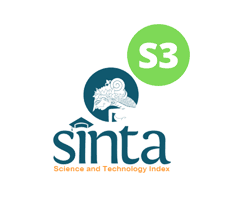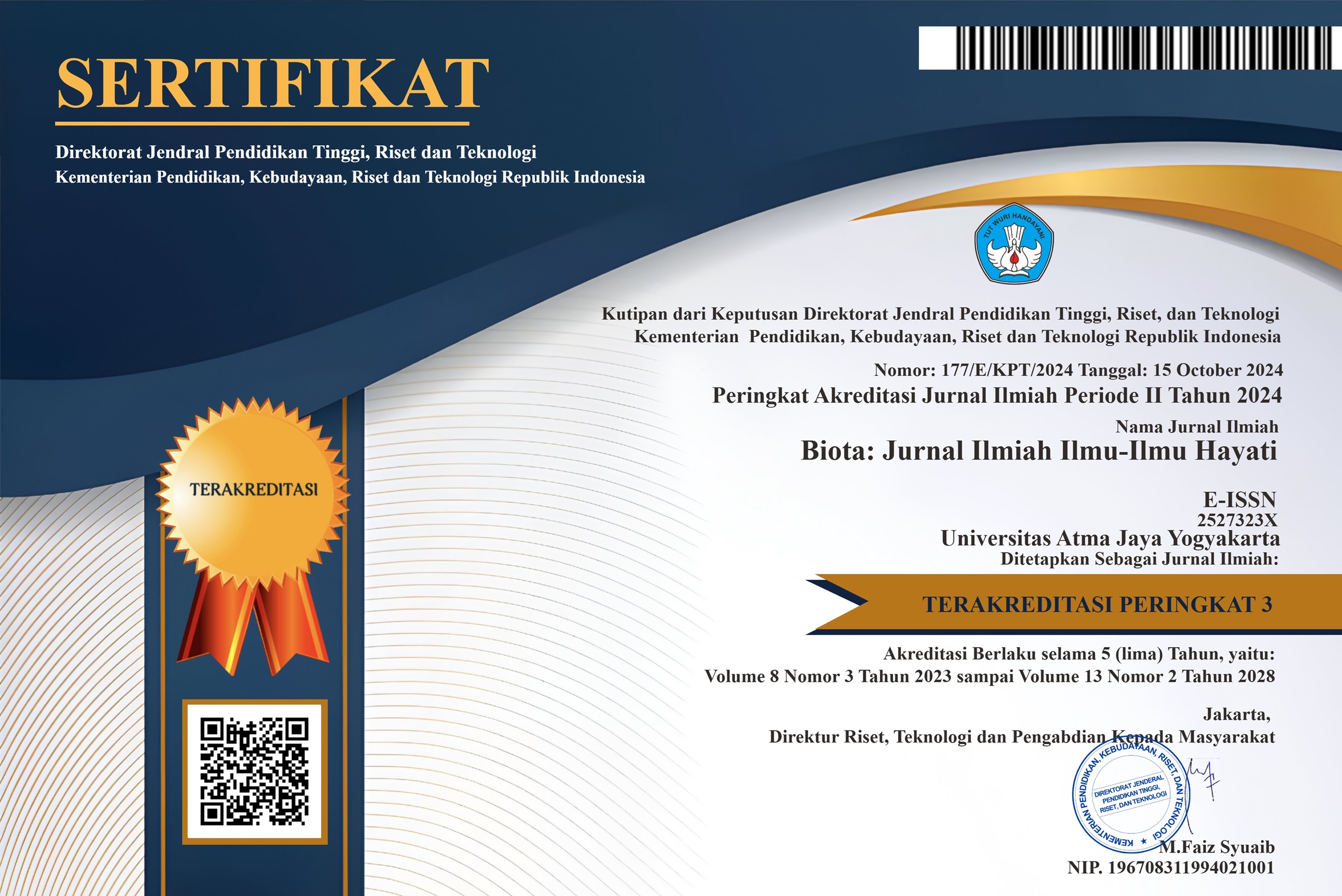Histological Structure of Male Wistar Rats’ Stomach Fed with Yam Tuber Flour Supplementation
DOI:
https://doi.org/10.24002/biota.v8i3.7166Keywords:
disocorin, gastric, residential rat, rodenticide, yamAbstract
A residential rat might harm human health because it acts as a disease reservoir. It has been many efforts to control this rate using synthetic rodenticide. Nevertheless, synthetic rodenticides broke the environment and made rats resistant. Yam (Dioscorea hispida) tube application on rat’s bite could solve the problem. This study evaluated the histology of male Wistar rats (Rattus norvegicus) fed with bite block supplemented with different yam tuber flour concertation to control residential rat populations. Five different treatments were applied with five replications. The treatments were negative control and brodifacoum 0.005% (positive control), 30%, 50%, and 70% of yam tuber flour. The results show that yam tuber supplementation caused damage to male Wistar rat stomachs, as indicated by mucosal erosion and the presence of inflammatory cells. The statistical test indicated that stomach damage significantly differed among treatments, with the severest damages caused by 50% yam tuber supplementation. It could be concluded that the rat’s bite containing yam tuber flour caused stomach damage, and the feed bite containing 70% yam tuber flour was the most effective. This result proved that yam tuber has good potential as a natural rodenticide to control residential rat populations.
References
Adeshina, I. & Emikpe, B. O. (2020). Pathogenicity, hematology, and pathology
of Listeria monocytogenes in rat. Comparative Clinical Pathology 29(1): 1-5.
Agboola, A. R., Okonkwo, C. O., Agwupuye, E. I. & Mbeh, G. (2022). Biopesticides and conventional pesticides: comparative review of mechanism of action and future perspectives. AROC in Agriculture 1(1): 14-32.
Boey, K., Shiokawa, K. & Rajeev, S. (2019). Leptospira infection in rats: a literature review of global prevalence and distribution. PLoS Neglected Tropical Diseases 13(8): e0007499.
Cruz, A. J. D. P., Raymundo, J. K. G., Jacinto, S. D., Tolentino, J. E. & Ipulan-Colet, L. A. D. G. (2022). Combining in vitro and in vivo assays to screen for anti-cancer and anti-angiogenic effects of the leaf extracts Mallotus cumingii Mull.Arg. (Euphorbiaceae). Malaysian Applied Biology 51(1): 73-82.
Dey, Y. N., Wanjari, M. M., Kumar, D., Lomash, V., Gaidhani, S. N. & Jadhav, A. D. (2017). Oral toxicity of elephant foot yam (Amorphophallus paeoniifolius) tuber in mice. Journal of Pharmacy & Pharmacognosy Research 5(1): 55-68.
Eisa, Y. A. E. & Yassin, E. M. A. (2016). Comparative studies between zinc phosphide and oshar leaves extract as a rodenticide against Norway rat Rattus norvegicus (Berkenhout) under laboratory and field conditions. Journal of Plant Protection and Pathology 7(4): 233 – 236.
Estiasih, T., Kuliahsari, D. E., Martati, E. & Ahmadi, K. (2022). Cyanogenic compounds removal and characteristics of non- and pregelatinized traditional detoxified wild yam (Dioscorea hispida) tuber flour. Food Science and Technology 42: e119121.
Hardiningsih, R., & Nurhidayat, N. (2006). Pengaruh pemberian pakan hiperkolesterolemia terhadap bobot badan tikus putih Wistar yang diberi bakteri asam laktat. Biodiversitas. 7: 127-130.
Kalinin, S., Marangoni, N., Kowal, K., Dey, A., Lis, A., Brodsky, S., van Breemen, R., Hauck, Z., Ripper, R., Rubinstein, I., Weinberg, G. & Feinstein, D. L. (2017). The long-lasting rodenticide brodifacoum induces neuropathology in adult male rats. Toxicological Sciences 159(1): 224-237.
Kappes, P. J., Siers, S. R., Leinbach, I. L., Sugihara, R. T., Jolley, W. J., Plissner, J. H., Flint, E. N., Goodale, K. L., & Howald, G. R. (2022). Relative palatability and efficacy of brodifacoum-25D conservation rodenticide pellets for mouse eradication on Midway Atoll. Biological Invasions 24: 1375-1392
Khidr, F. K., Abo-Hashem, A. A. M. & Mortada, M. M. (2018). Zinc phosphide and argel (Gomphocarpus sinaicus Boiss) leaves as a rodenticide on the Norway rat, Rattus norvegicus comparative studies under laboratory and field conditions. Journal of Plant Protection and Pathology 9(12): 909-912.
Kuswandi, M. R., Lintong, P. M. & Loho, L. L. (2017). Gambaran histopatologik lambung tikus Wistar (Rattus norvegicus Berkenhout, 1769) yang diberi minuman kopi (Coffea Arabica L). Jurnal e-Biomedik 5(1): 4-6.
Lokman, E. F., Muhammad, H., Awang, N., Omar, M. H., Mansor, F. & Saparuddin, F. (2017). Gene expression profiling associated with hepatoxicity in pregnant rats treated with ubi gadong (Dioscorea hispida) extract. International Journal of Biomedical Science 13(1): 26-34
Muhammad, H., Bakar, T. A. S. T. A., Yusery, M. F. A., Awang, N., Saad, W. M. M., Ibnu Rasid, E. N., Mahomoodally, M. F. & Omar, M. H. (2022). Oxidative stress and DNA damage effect of Dioscorea hispida Dennst. on placental tissues of rats. Molecules 27: 2190.
Ningtyas, D. A. R. & Cahyati, W. H. (2017). Uji daya bunuh umpan blok umbi gadung (Dioscorea hispida L) terhadap tikus. Kes Mas: Jurnal Kesehatan Masyarakat 11(2): 155-160.
Nosal, D. G., van Breemen, R. B., Haffner, J.W., Rubinstein, I. & Feinstein, D. L. (2021). Brodifacoum pharmacokinetics in acute human poisoning: implications for estimating duration of vitamin K therapy. Toxicology Communications 5(1): 69-72.
Ojimelukwe, P. C., Muoasinam, C. & Omodamiro, R. (2021). Current perspectives on the nutrient composition and health benefits of yams (Discorea species). International Journal of Agriculture, Environment and Food Sciences 5(2):179-190.
Ojuederie, O. B., Ajiboye, J. A. & Babalola, O. O. (2020). Biochemical and histopathological studies of key tissues in healthy male Wistar rats fed on African yam bean seed and tuber meals. Journal of Food Quality 2020: 8892618.
Paulsen, F. & Waschke, J. (2019). Sobotta Atlas anatomi Manusia, Organ Interna. Penerbit Elsevier. Amsterdam.
Posmaningsih, D. A. A., Purna I.N. & Sali, I. W. (2014). Efektivitas pemanfaatan umbi gadung (Dioscorea hispida) pada umpan sebagai rodentisida nabati dalam pengendalian tikus. Jurnal Skala Husada 11(1): 79 – 85.
Price, S. A. & Wilson, L. M. (2005). Patofisiologi Konsep Klinis Proses-Proses Penyakit, Buku I, Edisi Keenam. EGC. Jakarta.
Princewill-Ogbonna, I. L., Abagha, O. J. & Ijioma, S. N. (2015). Hematological and histopathological parameters of rats fed with aerial yam (Dioscorea bulbifera). Comprehensive Journal of Food Science and Technology Research 2(2): 09-16.
Prompiram, P., Poltep, K., Pamonsupornvichit, S., Wongwadhunyoo, W., Chamsai, T. dan Rodkvamtook, W. (2020). Rickettsiae exposure related to habitats of the oriental house rat (Rattus tanezumi, Temminck, 1844) in Salaya suburb, Thailand. International Journal for Parasitology: Parasites and Wildlife 13: 22-26.
Raina, A. P. & Misra, R. C. (2020). Evaluation of diosgenin, a bioactive compound from natural resource of Dioscorea species: a wild edible tuber plant. Journal of Pharmacognosy and Phytochemistry 9(1): 1120-1124.
Rasid, I. N. I., Azlan, A. R., Daud, N. F. M., Shah, T. A., Awang, N., Saad, W. W. Md. & Muhammad, H. (2020). Effect of Dioscorea hispida var. Daemona (Roxb) Prain & Burkill on oxidative stress and DNA damage in the liver of pregnant rats. International Journal of Biomedical Science 16(3): 30-36.
Santi, S.R. (2010). Senyawa aktif anti makan dari umbi gadung (Dioscorea hispida Dennts). Jurnal Kimia 4(1): 71-78.
Saraf, V., Pande, S., Gopalakrishnan, U., Balakrishnan, D., Menon, R. N., Sedheer, O. V., Dhar, P. & Sudhindran, S. (2015). Acute liver failure due to zinc phosphide containing rodenticide poisoning: Clinical features and prognostic indicators of need for liver transplantation. Indian J Gastroenterol 34(4): 325-329.
Sari, D. E., Fitrawati & Bahtiar. (2020). Effect of Dioscorea hispida dennst. against Rattus sp. IOP Conf. Series: Earth and Environmental Science 484: 012109
Shafira, S. N., Kairupan, C.F. & Durry, M. F. (2016). Gambaran histopatologik lambung tikus Wistar (Rattus norvegicus Berkenhout, 1769) yang diinduksi asam mefenamat dan diberi susu kental manis. Jurnal e-Biomedik 4(2): 3.
Shiels, A. B., Pitt, W. C., Sugihara, R. T. & Witmer, G. W. (2014). Biology and impacts of Pacific Island invasive species. 11. Rattus rattus, the black rat (Rodentia: Muridae). USDA National Wildlife Research Center - Staff Publications. 1404. https://digitalcommons.unl.edu/icwdm_usdanwrc/1404.
Susatyo, P., Lestari, W., Sugiharto & Chasanah, T. (2022). Reproductive aspects of javaen barb fish, Systomus orphoides in the initial domestication program. Biodiversitas 23(3): 1511-1519.
Teng, P., Kairupan, C. & Loho, L. (2013). Gambaran Histopatologi Lambung Tikus Wistar yang Diberi Cabe Rawit (Capsicum frutescens). Jurnal e-Biomedik 1: 1109-1113.
Trakulsrichai, S., Kosanyawat, N., Atiksawedparit, P., Sriapha, C., Tongpoo, A., Udomsubpayakul, U., Rittilert, P. & Wananukul, W. (2017). Clinical characteristics of zinc phosphide poisoning in Thailand. Therapeutics and Clinical Risk Management 13: 335-340.
Yalcin, E., Cavusoglu, K., Acar, A. & Yapar, K. (2019). In vivo protective effects of Ginkgo biloba L. leaf extract against hydrogen peroxide toxicity: cytogenetic and biochemical evaluation. Environmental Science and Pollution Research 27: 3156-3164.
Younis, A. E., Saad, A. I., El-Akhal, I. R. M. & Saleh, N. M. K. (2021). A parasitological survey of zoonotic cestodes carried by house rats in Aswan, Egypt, reveals cryptic diversity at the molecular level. Veterinary World 14(8): 2160-2169.
Downloads
Published
How to Cite
Issue
Section
License
Copyright (c) 2023 Andre Dian Permana, Yasmi Purnamasari Kuntana, Desak Made Malini

This work is licensed under a Creative Commons Attribution-NonCommercial 4.0 International License.
Authors who publish with Biota : Jurnal Ilmiah Ilmu-Ilmu Hayati agree to the following terms:
- Authors retain copyright and grant the Biota : Jurnal Ilmiah Ilmu-Ilmu Hayati right of first publication. Licensed under a Creative Commons Attribution-NonCommercial 4.0 International License that allows others to share the work with an acknowledgment of the work's authorship and initial publication in this journal.
- Authors are able to enter into separate, additional contractual arrangements for the non-exclusive distribution of the journal's published version of the work (e.g., post it to an institutional repository or publish it in a book), with an acknowledgment of its initial publication in Biota : Jurnal Ilmiah Ilmu-Ilmu Hayati, and as long as Author is not used for commercial purposes.













